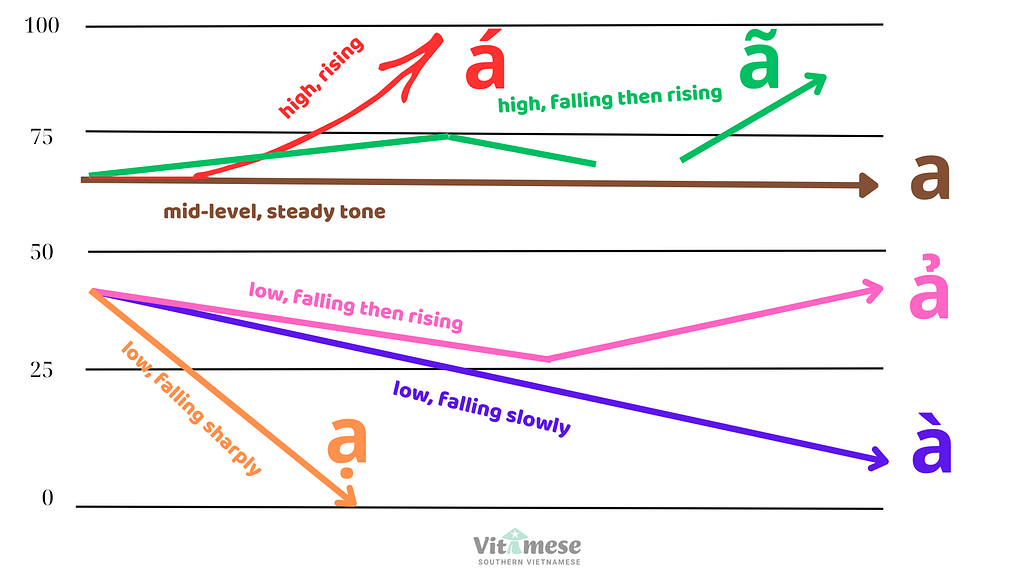Vietnamese is a tonal language, which means the tone of your voice when pronouncing a word can completely change its meaning. Unlike English, where tone mainly adds emotion or emphasis, in Vietnamese, tone is essential to the meaning of a word. This can be surprising for many foreigners learning the language.
Vietnamese uses the Latin alphabet with additional tone marks (dấu thanh) placed above or below vowels. There are six tones in Vietnamese, each represented by a specific mark (or no mark at all):
1. Flat tone (ngang) – No tone mark. The tone is mid-level and flat.
Example: ma (ghost)
2. Rising tone (sắc) – Marked with ´ above the vowel. The tone is high, rising.
Example: má (mother)
3. Falling tone (huyền) – Marked with ` above the vowel. The tone falls slowly.
Example: mà (but)
4. Questioning tone (hỏi) – Marked with ̉ above the vowel. The tone is low, falling then rising.
Example: mả (grave)
5. Tumbling tone (ngã) – Marked with ~ above the vowel. The tone is high, falling then rising.
Example: mã (code or horse)
6. Heavy tone (nặng) – Marked with . below the vowel. The tone is low, falling sharply.
Example: mạ (rice seedling)
Each of these tones gives a different meaning to what may look like the same word. “ma” can mean six completely different meanings depending on its tone!
Understanding and practicing the tones is essential when learning Vietnamese. It may seem difficult at first, but with listening and repetition, learners can train their ears and voice to hear and pronounce the tones correctly.
For further reference, watch these video:
・6 tones practicing: https://www.youtube.com/watch?v=JUmA5UFvCPc
・ No tone & falling tone: https://www.youtube.com/shorts/MHcGIXlsFSA
・ Rising tone & questioning tone: https://www.youtube.com/shorts/JZ0A-lj7QZw
・ Tumbling tone & heavy tone: https://www.youtube.com/shorts/t578N8467Yc
Reference: Gotoviki
Vietnamese uses the Latin alphabet with additional tone marks (dấu thanh) placed above or below vowels. There are six tones in Vietnamese, each represented by a specific mark (or no mark at all):
1. Flat tone (ngang) – No tone mark. The tone is mid-level and flat.
Example: ma (ghost)
2. Rising tone (sắc) – Marked with ´ above the vowel. The tone is high, rising.
Example: má (mother)
3. Falling tone (huyền) – Marked with ` above the vowel. The tone falls slowly.
Example: mà (but)
4. Questioning tone (hỏi) – Marked with ̉ above the vowel. The tone is low, falling then rising.
Example: mả (grave)
5. Tumbling tone (ngã) – Marked with ~ above the vowel. The tone is high, falling then rising.
Example: mã (code or horse)
6. Heavy tone (nặng) – Marked with . below the vowel. The tone is low, falling sharply.
Example: mạ (rice seedling)
Each of these tones gives a different meaning to what may look like the same word. “ma” can mean six completely different meanings depending on its tone!
Understanding and practicing the tones is essential when learning Vietnamese. It may seem difficult at first, but with listening and repetition, learners can train their ears and voice to hear and pronounce the tones correctly.
For further reference, watch these video:
・6 tones practicing: https://www.youtube.com/watch?v=JUmA5UFvCPc
・ No tone & falling tone: https://www.youtube.com/shorts/MHcGIXlsFSA
・ Rising tone & questioning tone: https://www.youtube.com/shorts/JZ0A-lj7QZw
・ Tumbling tone & heavy tone: https://www.youtube.com/shorts/t578N8467Yc
Reference: Gotoviki
